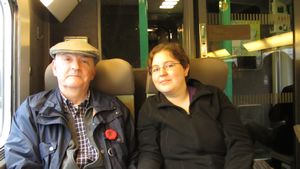Advertisement
Published: November 19th 2011

 On the Train
On the Train
Dad and Me on our way to Vimy.Today we took the train up to the northern part of France to see the Vimy Ridge memorial. During the first World War the Germans had control of the ridge and was a key position of the German line in Northern France. If the allies could capture the ridge it would expose vast territory of German held positions to allied sight and allied guns, and help give the allies a commanding view of the entire Douai Plain. Vimy Ridge was so well fortified that all previous attempts to capture it had failed. The British and French had been trying to capture the Ridge since the beginning of the war and with upwards of 150,000 casualties little progress had been made. The taking of Vimy Ridge was the first time that all 4 Canadian Corps would be fighting together known as Canadian soldiers rather than British citizens. Canadian commanders had learned bitter lessons from the cost of past frontal assaults made by vulnerable infantry. This time their preparations were elaborate. As the Canadian Commander of the 1st Division, Major-General Arthur Currie, said,"Take time to train them." This is exactly what the Canadian Corps did, down to the smallest unit and the individual

 On the Train
On the Train
Mom enjoying the countryside on our way to Vimy.soldier. A full-scale replica of the battle area was laid out behind the Canadian lines. Here Canadian units carried out repeated exercises, rehearsing exactly what they would do throughout the day of the attack. On April 9 1917 Canadian Forces attacked the German lines and by April 12 they had control of the Ridge. Military mining had long been a feature of war on Vimy Ridge. German, French and British engineers had dug many long tunnels under No Man's Land. They filled them with explosive charges, which blew up enemy trenches, leaving huge craters as new features of the landscape. Working at night, tunneling companies used the existing tunnels to build a new underground network for the Vimy assault. We had the opportunity to go down into the tunnels and they are still pretty extensive and when they turned the lights off, very dark!! It was a great day, you could still see in the landscape where the twisting trenches would have been.
It has often been said that Canada’s sons left their home as young colonials but returned as Canadians. Vimy is indeed the birthplace of “Canadian Nationhood”. The price was heavy: 10,500 casualties, including 3,598 dead.
Advertisement
Tot: 0.301s; Tpl: 0.013s; cc: 9; qc: 50; dbt: 0.0565s; 1; m:domysql w:travelblog (10.17.0.13); sld: 1;
; mem: 1.1mb

 On the Train
On the Train
 On the Train
On the Train






























